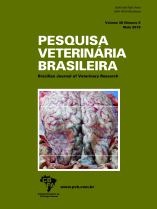 |
|
|
|
Year 2018 - Volume 38, Number 5
|

|
Urinary fractional excretion of sodium, potassium and chloride in lambs supplemented with ammonium chloride to prevent urolithiasis, 38(5):870-874
|
ABSTRACT.- Ferreira D.O.L., Santarosa B.P., Sacco S.R., Pereira P.F.V., Camilo S.L.O., Lisbôa J.A.N. & Gonçalves R.C. 2018. [Urinary fractional excretion of sodium, potassium and chloride in lambs supplemented with ammonium chloride to prevent urolithiasis.] Excreção fracionada urinária de sódio, potássio e cloreto em cordeiros suplementados com cloreto de amônio para prevenção de urolitíase. Pesquisa Veterinária Brasileira 38(5):870-874. Departamento de Clínica Veterinária, Faculdade de Medicina Veterinária e Zootecnia, Universidade Estadual Paulista, Campus de Botucatu, Distrito de Rubião Júnior, Botucatu, SP 18618-970, Brazil. E-mail: biancasantarosavet@gmail.com
Urolithiasis is an important disease of lambs confined. The urine acidification, by ammonium chloride intake, is the preventive method most frequently employed. Due to the lack of specific information in sheep, this study was performed to evaluate the electrolyte changes that occur in the urine of lambs receiving ammonium chloride in the diet. One hundred male lambs, 3 months old, were kept in a feedlot during 56 days, and distributed in 3 groups: G1 (n=40) receiving 400mg/kg BW of ammonium chloride/day during 21 days; G2 (n=40) receiving 400mg/kg BW of ammonium chloride/day during 42 days; and G3 (n=20) that did not receive ammonium chloride. The lambs were examined and blood and urine samples were collected every 7 days: 0 (the beginning of ammonium chloride intake), 7, 14, 21, 28, 35, and 42 days. Serum and urine sodium (Na+), potassium (K+), chloride (Cl-), and creatinine concentrations were measured. The urinary fractional excretion (FE) of electrolytes and the urine strong ion difference [(Na+ + K+) - Cl-] were calculated. FEs of Na+, K+, and Cl- did not vary over time in G3, proving that the feedlot diet, by itself, did not influence the urinary excretion of these electrolytes. The ingestion of ammonium chloride, instead, influenced FEs over the time of feedlot. The urinary SID was more accurate than the FE of Cl- to demonstrate that the concentration of Cl- increased in the urine. It highlights the relevance of this variable. |
| |
|
|
| |
|
 |